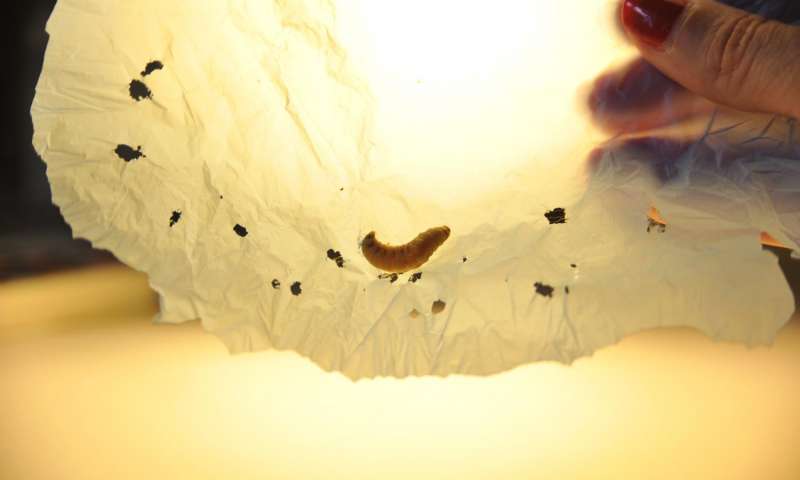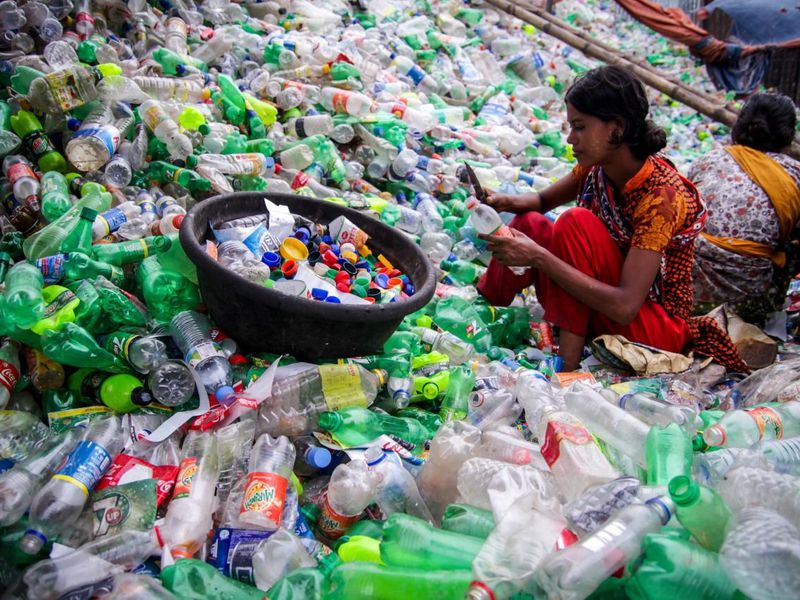Nature’s Innovators: plastic consumers
Key concepts:
• accidental discovery shatters prior assumptions
• polyethylene was formerly thought not to be biodegradable but…
• bacteria in the gut of wax caterpillar can process polyethylene rapidly
• polyethylene, used to make shopping bags, has been the worst single use plastic, clogging landfills
• PET, used to make plastic bottles, has been the second major offender, and it too may have a bacterial consumer
Polyethylene (PE), used to make plastic shopping bags, is one of the toughest and most widely used plastics. It is often found in quantity clogging landfill sites and has been considered nonbiodegradable for decades. Although the biodegradation of PE by bacterial cultures has been occasionally described, valid evidence of PE biodegradation was limited.
Through an accident a caterpillar that could eat this plastic was discovered.

When around a hundred “wax worms” were placed temporarily in a plastic bag from a UK supermarket, holes started to appear after just 40 minutes. There was a reduction in plastic mass of 92mg from the bag after 12 hours. This degradation rate was extremely fast compared to other recent discoveries. The caterpillar produced something that breaks the chemical bond in plastic, although scientists are are still trying to identify the molecular processes in this reaction to try to isolate the enzyme responsible.
Scientists found that this caterpillar commercially bred for fishing bait that can biodegrade polyethylene. This wax worm, the larvae of the common insect Galleria mellonella, or greater wax moth, attacks beehives across Europe, living as parasites on bee colonies. Wax moths lay their eggs inside hives. The worms hatch and grow on beeswax – hence the name.
A chance discovery occurred when one of the scientific team, Federica Bertocchini, an amateur beekeeper, was removing the parasitic pests from the honeycombs in her hives. The worms were temporarily kept in a typical plastic shopping bag that became riddled with holes.
Bertocchini, from the Institute of Biomedicine and Biotechnology of Cantabria (CSIC), Spain, collaborated with colleagues Paolo Bombelli and Christopher Howe at the University of Cambridge’s Department of Biochemistry to conduct a timed experiment.
We found that waxworms, or Indian mealmoths (the larvae of Plodia interpunctella), were capable of chewing and eating PE films. Two bacterial strains capable of degrading PE were isolated from this worm’s gut, Enterobacter asburiae YT1 and Bacillus sp. YP1. Previously known bacteria biodegraded plastics much more slowly, at a rate of just 0.13mg a day. Scientific American has reported on their discovery.
Polyethylene Terephthalate (PET)
PET has been highly resistant to being broken down by microbes, i.e. very non biodegradable. Because PET is a polyester compound with a high aromatic content, it is chemically inert, and so generally resistant to microbial degradation, although certain fungi grow on a mineral medium containing PET.
However, now there’s a breakthrough. The Kyoto University research team has identified one gene, ISF6_4831 that encodes a protein that shares half of its amino acids with another enzyme that hydrolyzes PET. This research affords potential for remediation of the now-overabundance of trashed items made of PET. The Smithsonian, and many others, reported on this discovery.
Tests in the lab revealed that these bacteria use two enzymes to break down PET. After adhering to the PET surface, the bacteria secrete one enzyme onto the PET to generate an intermediate chemical, which is then absorbed by the cell, where another enzyme breaks it down further, providing the bacteria with carbon and energy to grow. The researchers report that a community of Ideonella sakaiensis working this way could break down a thin film of PET over the course of six weeks if the temperature were held at a steady 86 degrees Fahrenheit. Further research and development may reveal how bacteria can efficiently clean up PET waste. MORE
Science Driving Innovation
A team of scientists in Japan, led by Shosuke Yoshida of Kyoto University, recently discovered a species of bacteria that can degrade the plastic referred to as PET (polyethylene terephthalate), as reported in the journal Science. PET is used to manufacture plastic bottles for water and soft drinks and in many other products. The widespread use of PET is because it is lightweight, colorless and strong. Roughly 56 million tons of PET are produced each year, much of which ends up as environmental trash.
PET has been highly resistant to being broken down by microbes, i.e. very non biodegradable. Because PET is a polyester compound with a high aromatic content, it is chemically inert, and so generally resistant to microbial degradation, although certain fungi grow on a mineral medium containing PET.
However, now there’s a breakthrough. The Kyoto University research team has identified one gene, ISF6_4831 that encodes a protein that shares half of its amino acids with another enzyme that hydrolyzes PET. This research affords potential for remediation of the now-overabundance of trashed items made of PET. The Smithsonian, and many others, reported on this discovery.
Tests in the lab revealed that these bacteria use two enzymes to break down PET. After adhering to the PET surface, the bacteria secrete one enzyme onto the PET to generate an intermediate chemical, which is then absorbed by the cell, where another enzyme breaks it down further, providing the bacteria with carbon and energy to grow. The researchers report that a community of Ideonella sakaiensis working this way could break down a thin film of PET over the course of six weeks if the temperature were held at a steady 86 degrees Fahrenheit. Further research and development may reveal how bacteria can efficiently clean up PET waste. MORE
The job of sorting for recycling may be over, if these bacteria can recycle these materials.

More information: Current Biology (2017). DOI: 10.1016/j.cub.2017.02.060
Gut bacteria from a worm can degrade plastic
“Evidence of Polyethylene Biodegradation by Bacterial Strains from the Guts of Plastic-Eating Waxworms” Environ. Sci. Technol., 2014, 48 (23), pp 13776–13784, DOI: 10.1021/es504038a
See the app @ earthDECKS.org
Saving Our Oceans from Plastic: articles by Zann Gill
- Adverse Health Effects of Plastic
- Aquaria – Informal Learning Network
- Beat the Microbead
- Bibliography: Plastic Roads
- Boyan Slat: Floater Technology for Ocean Cleanup
- Complex Systems Problems
- Cradle to Grave: Plastic Supply Chain
- Dame Ellen MacArthur: The Circular Economy
- Sylvia Earle: Learning for a Plastic World
- earthDECKS Limelights: Companies to Watch
- Enshrouded in Plastic
- Flamingos Signal the Future We Face
- Floating Trash: More than 4x as bad as we thought
- Give the World a Helping Hand: 3D Prostheses
- Global Ocean Sensing
- Industry Response to the Plastic Challenge
- Nature’s Innovators: plastic consumers
- Ocean Debris Network
- Ocean Ingenuity
- Oceans – Measuring Planet Health
- Plastic Bank – The Exchange Economy
- Plastic – Climate Change Connection: Israel & UBQ
- PLASTIC: Complex Systems Problem
- Plastic: Drinking Water, Table Salt & Mother’s Milk
- Plastic Footprint – Carbon Footprint
- Plastic-Eating Enzyme
- Plastic Gyres and Social Justice
- Plastic Impact Calculator
- Plastic Pollution Coalition: Campaign vs Single Use Plastic
- Plastic & Public Health: Endocrine Disruptors
- PLASTIC: Overview of National Leadership
- Plastic Roads – Global Innovation Ecosystem
- Plastic – The Circular Economy
- The Plasticene
- Plastiki: adventure stories & a big message
- Raising Awareness of Plastic Hazards
